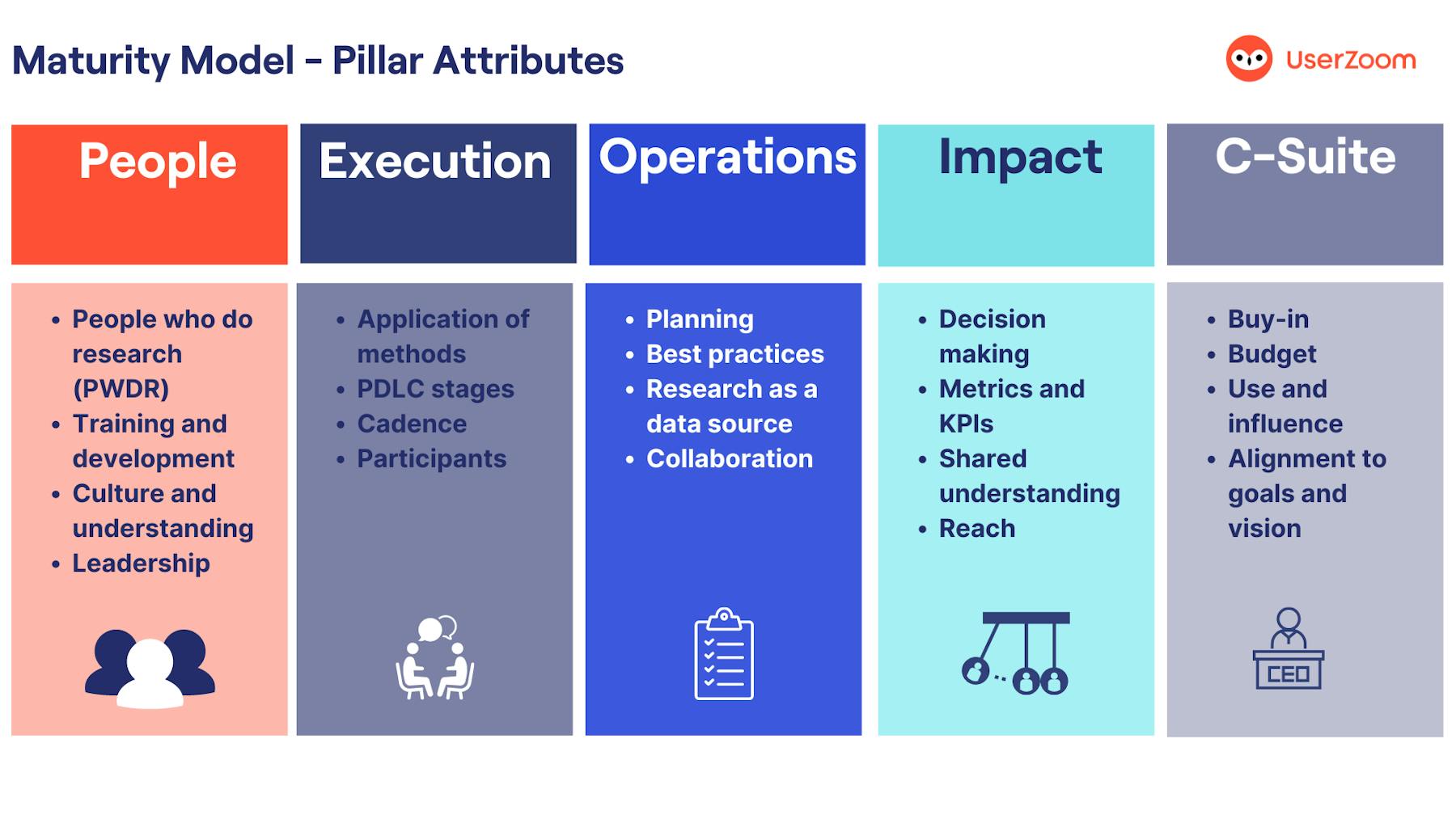
UXR maturity model

When our customers need to gauge their own progress accurately, we use our UX research maturity model (UXR) to provide a framework that illustrates where the organization is today—its maturity level—and which activities will be most effective, helping them elevate their UXR practice.
In this article, we’ll explore how and why the model was created and introduce some key components.
Why understanding UXR maturity is important
With UXR maturity, many believe that if you choose your team carefully, and have the right expertise and setup, then with time, the UXR practice will mature effectively. But simply relying on time often puts us in a loop of just doing research, where our team is conducting research, but we don’t see the bigger picture: How can we increase our impact across the organization? That’s why understanding where we’re at and where we want to go can help UXR practices to progress rather than stall.
Origins of the UXR Maturity Model
I work in a UXR consultatory position with organizations of different sizes, set-ups, and industries worldwide. This exposure gives my team and me a behind-the-scenes view of how UXR functions are operating and how they are evolving over time to meet the needs of their organization's digital product development.
Unfortunately, this journey to mature UXR isn’t easy or simple. If it were, we'd all be doing it, right? Many organizations are unclear about how to progress, fail to take the time, or don’t have the time to contemplate and strategize different approaches.
When we created the model, existing materials for progressing UXR maturity often provided very limited insight into what the journey looks like or what would help drive the change. We found that existing models often touch upon UXR as a small component of UX and Design maturity—boiling research down to a single bullet point to explain what it may look like at different maturity stages.
With this in mind, we set out to define a maturity model that would focus specifically on the maturity of UXR. We used everything at our disposal—evaluating existing maturity models, analyzing customer data, conducting interviews with customers and other industry resources—to build out what the journey of maturing UXR looks like, no matter the size or industry the organization operates in. We needed to use what existed already and build upon it to fill in existing gaps and iterate as we developed this model.
The model was built to:
- Help show an organization’s current UXR maturity
- Allow organizations to compare themselves to others
- Enable organizations to think both strategically and tactically about how they can mature
- Look at all components of research practice
5 key pillars of UX maturity

When measuring an organization’s UX maturity, we look at five key pillars:
Pillar 1: People
The first pillar of the model explores people. More specifically, looking at those who conduct and represent UXR in an organization and the environment in which they operate.
The specific areas, or indicators, we explore as part of the people pillar includes:
- People who do research (PWDR): Who are the main “doers” of research in an organization? What are their levels of UXR competency, and who do they interact with?
- Training and Development is focused on understanding how the organization supports individuals to become better at conducting and utilizing research in their roles.
- Culture and Understanding look at the organization’s collective understanding of UXR, and how this view affects and influences the organization’s operations and decisions.
- Leadership explores how UXR is represented at a leadership level within the organization and what career paths exist for UXRs.
Pillar 2: Execution
The second pillar is execution: Centred on how the organization conducts research. It’s important to go beyond the methodologies being used and explore the “how, why, when, and with whom” of research being conducted.
The indicators we explore as part of the execution pillar include the following:
- Methods Applied looks at what methods are available and used to understand the organization’s users.
- Product Development Lifecycle (PDLC) is about understanding the points in the PDLC that research is incorporated.
- Cadence builds on the above and looks at the regularity with which the organization learns and gains insights from its users.
- Participants are centered around the processes and practices for recruiting users and who those users are.
Pillar 3: Research Ops
The third pillar is research ops. Many of you may be familiar with the Research Ops community’s brilliant work on the UX Research Operations landscape map. A number of those aspects are part of this pillar and some are included in other pillars.
For the purpose of our model, Research Ops looks at the level of standards, processes, and rigor that support the practice in an organization.
The indicators we explore as part of the Research Ops pillar include:
- Planning covers how the organization prioritizes and maps its research agenda to the goals of the organization.
- Best Practices looks at how UXR best practices are recorded, shared, and standardized across the organization.
- UXR as a data source reviews the process of storing research data and findings, including how the findings can be accessed and shared across the organization.
- Collaboration explores how the organization makes the research a collaborative activity, maximizing its impact and effectiveness.
Pillar 4: Impact
The fourth pillar is impact. High-quality research is only as good as the value and action it drives. This pillar explores how influential UXR is across the organization in terms of the direction it provides and its perceived impact on the business.
The indicators we explore as part of the impact pillar include:
- Decision-making looks at how UX research is used when it comes to the direction of an organization’s products.
- Shared understanding explores if there is an understanding across the organization of its users and their experiences.
- Measurement looks at what UX KPIs/Metrics exist and how UXR aids in measuring, socializing, and ultimately connecting these back to business goals.
- Influence uncovers who in the organization is influenced by UX research (and to what degree).
Pillar 5: C-suite
The final pillar of the model is referred to as c-suite. It involves the relationship that UXR has with the most senior members of the organization. This is something that many organizations struggle to establish, but those that do are often the most successful and influential of the UXR practices.
The indicators we explore as part of the c-suite pillar include:
- Buy-in looks at the importance placed, interest in, and understanding of the benefits of UXR at the most senior levels of the organization
- Budget looks at the investment in UXR. Organizations that see the value of UXR and understand how it works dedicate budget to UXR practices and allow flexibility in budget to adjust to demand.
- Exposure and Influence revolve around how the senior levels of the organization are exposed to UXR, and how it influences and helps shape their decision-making.
Communication and collaboration are key, and may take the form of a UX research report or presentation. At its core, UXR is about building and aligning overall business strategy to the wants and needs of the user. This is why UXR’s alignment to the vision and goals of their organization is an important indicator for this pillar.
Understanding your own UXR maturity
These pillars and their indicators allow our customers a better understanding of where they are from a UXR maturity perspective, and provide guidance on how to move the needle within their organization.


